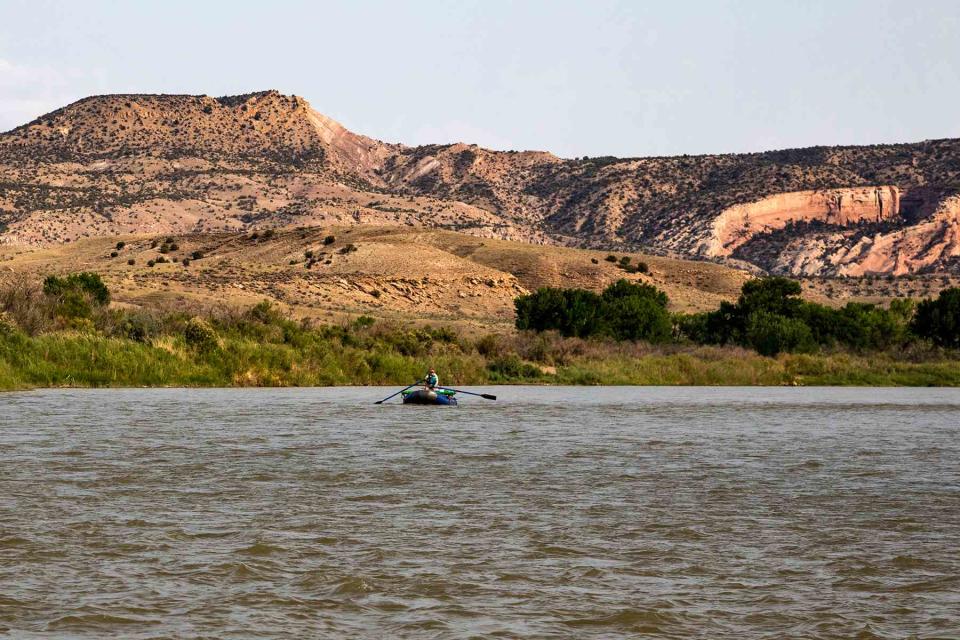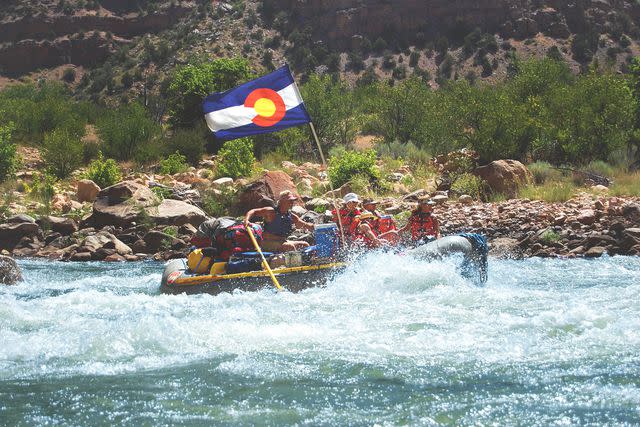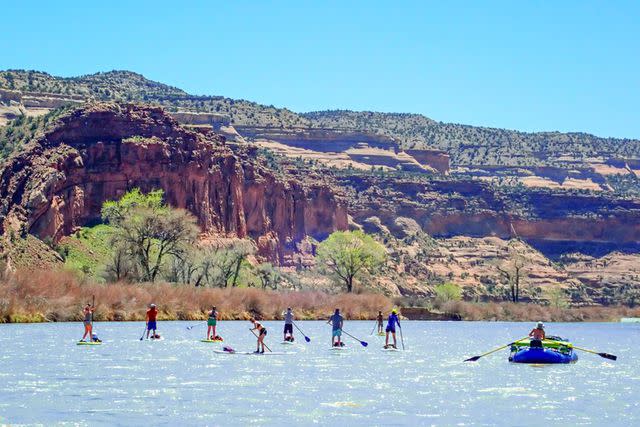How to Take a Colorado River Rafting Trip This Fall — Cliff Jumping, Wildlife Spotting, and Canyon Hikes Included
One travel writer heads to Colorado's Ruby-Horsethief Canyon for a river rafting adventure with her family — and maps out how you can take a similar trip this fall.

Bob Wick/Courtesy of BLM Colorado
In Colorado, the moment the snow stops falling, the rafts come out. Wide-brimmed sun hats replace knit beanies, and everyone heads outside to bask in the warmer temperatures.
But even though I grew up in Colorado, I've never been what you’d call a “rafter.” Sure, I made a couple multi-day raft trips as a kid, but as an adult, I always seem to end up at home, watching enviously as neighbors pull out their river gear for a little fun.
This year, I was determined to make a change. Thanks to my ambitious brother (hey, Paul), my non-rafting family became one — for a long weekend at least. All 11 of us — including a nine-month-old baby, a dog, and two pre-teens — spent three days and two nights on the Ruby-Horsethief Canyon section of the Colorado River.
TL;DR: It was awesome. Ready to plan your own fall rafting adventure? Here's how we did it as total newbies — and how you can, too.

Courtesy of Visit Grand Junction
What to Expect
If you're new to this, you've come to the right place. Ruby-Horsethief Canyon is an excellent stretch of river for people with little-to-no rafting experience. The water is flat and slow-moving, and the "rapids" are tiny, almost non-existent. Most people run the 25-mile stretch of river in two days, but you can add a day or two (we did three days) so you have time for a few side adventures — you'll pass plenty of swimming holes, hikes, and little islands that are perfect for a midday picnic.
The journey begins at Loma Boat Ramp, just outside Fruita, Colorado, and ends at Westwater Boat Ramp in Westwater, Utah. You'll need to leave a car at Westwater so you have a way to get your other vehicle(s) at Loma when you finish the trip. It takes just over an hour to shuttle a car out to Westwater and get back to Loma for the launch.
What to Pack
If you're like me, you don't have a giant raft sitting in your garage. For our group of 11, we rented two, 18-foot rafts with oars and an inflatable kayak (a.k.a. a "ducky") from Rimrock Adventures in Fruita, Colorado. The rafts came with two giant coolers and two camp tables. We also rented life jackets, dry bags for stowing our gear, and most importantly, the groover (a.k.a. the toilet).
Rimrock Adventures delivered everything to the Loma Boat Ramp on our departure day and met us at the Westwater Boat Ramp for pickup, making it a seamless effort. The only trick is setting a pickup time that will give you enough time to enjoy your final day but not so much time that you have to spend hours hanging at the Westwater Boat Ramp.
To give us a little shade on the raft, we brought a giant patio umbrella that we attached to the raft using bungee cords. You'll be in the sun all day, so a wide-brim sun hat, sun shirt, and sunglasses (I brought my Dragon DRAC sunglasses, which float) are all critical. You'll also want a pair of Tevas, Chacos, or some sort of sandal that won't fall off when you jump in and out of the water.
You'll need a sun shelter to cook and hang under at the campsite and all the standard camping gear (tent, sleeping bag, camping chair, etc.). You'll also need to keep the season and weather in mind. We were battling bugs, sun, and heat when we went in mid-July. But in the winter and spring, you might need things like wool socks, gloves, and down jackets. The great thing about rafting is that you don't have to worry about weight, and there's plenty of room. If in doubt, bring it.
Where to Camp
Reserving campsites is the trickiest part. What sites are "good" depends on everything from the weather to group size. Some sites have perks like a hiking trail, cliff jumping, or even a beach.
We had a dog and a baby along for the ride, so shady, dog-friendly campsites were a must. We stayed at Rattlesnake Camp on the first night, just 3 miles from the Loma Boat Ramp. There was shade, a clay beach, cliff jumping, and a hiking trail up Rattlesnake Canyon. We followed this up with an overnight on Dog Island, a dog-friendly island in the middle of the river. (Be warned: There is minimal shade on the island.)
Other excellent campsites include Mee Corner (we stopped there briefly and saw desert bighorn sheep) and all the Black Rock sites, which are on the most beautiful section of the river but offer little-to-no shade. For a full campsite rundown, check out Go Rafting's entire list of destinations.

Courtesy of Visit Grand Junction
What to See
The best part about being on this stretch of river is the slow pace, canyon views, and wildlife sightings. We spotted eagles and blue herons daily and even came across a family of desert bighorn sheep.
On the second day, we floated under the route's iconic red rock cliffs, and on our final day, we stopped in the Black Rocks section of the river and went cliff jumping. The rock dates back about 1.7 billion years, making you feel like you're meandering through history on the water.
What to Know and When to Go
Ruby-Horsethief is remote, so cell service is non-existent. You'll need to pack out all your trash and follow the Leave No Trace policies. Typically, there's a fire ban from Memorial Day to Labor Day.
Keep in mind that the weather on the river can turn quickly. Rafters might have a hot, muggy day followed by snow and high winds — you have to be ready for anything. Most rafters do the Ruby-Horsethief between May and October, but it is doable in the winter (and camp permits are free) — you'll just want to bring proper camping gear and plenty of warm layers. The weather is variable in the spring, and in the summer things can get very hot with the odd violent rain storm thrown in. Fall tends to be the best time to raft Ruby-Horsethief — the days are still warm, the nights are cool, and the rain is infrequent.
How to Get a Permit
If you want to spend a night or two on the river, you'll need to apply for a permit on Recreation.gov. You can reserve your camping permits two months in advance on a daily rolling window. Reservations open daily at 8 a.m. MT.

